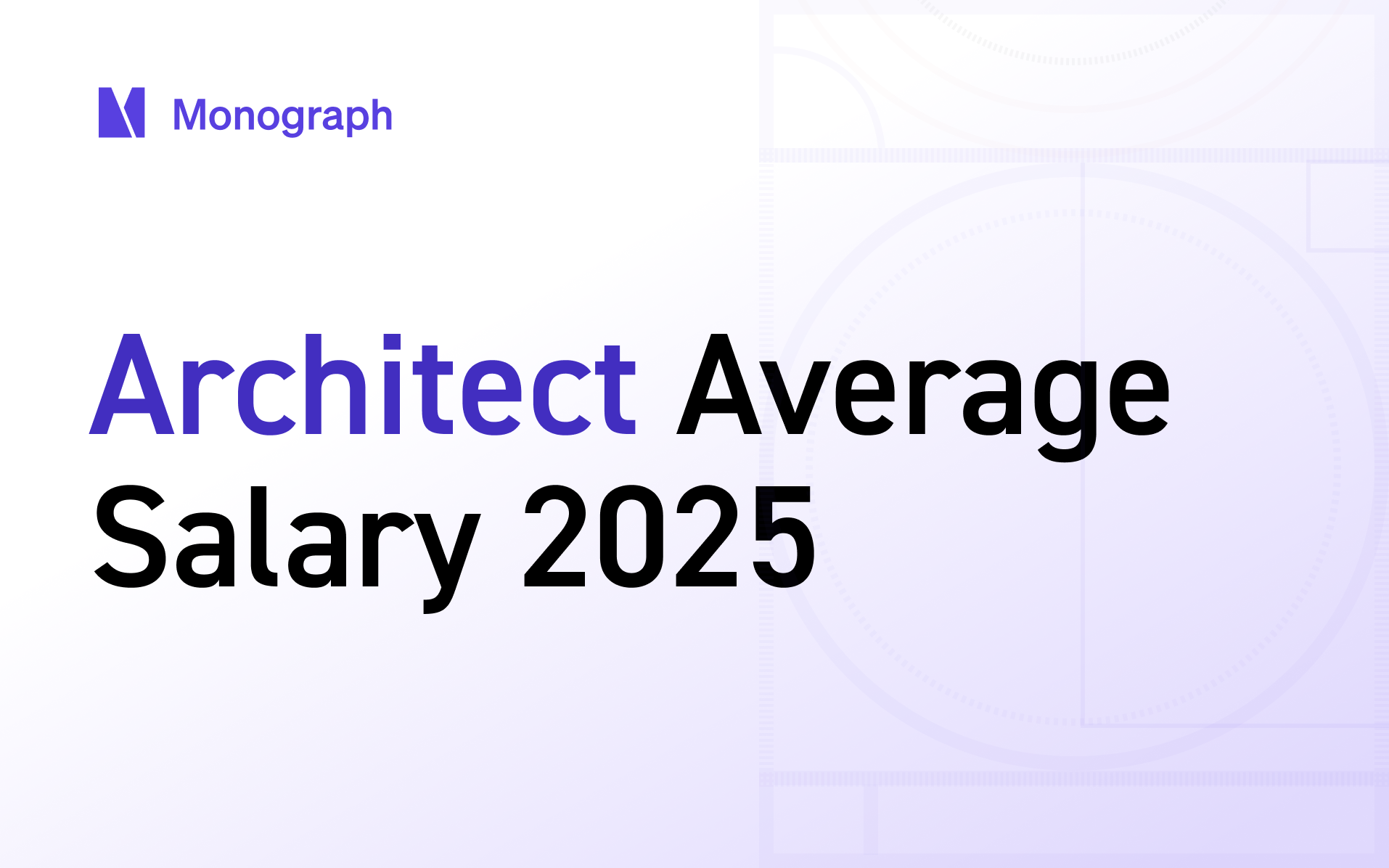Contents
When your best project architect walks out mid-project, your schedule just became expensive chaos. Delays stack up. Deadlines shift. Overtime creeps in. And suddenly, what looked like a profitable project now threatens your margins.
It’s a familiar story. Often, it starts long before the resignation letter hits your desk. The average architect salary in 2025 is $97,470, but do you know where your team sits relative to the market, or what it really costs your firm when talent jumps ship?
After working with 1,500+ architecture firms and 12,000+ architects, we've learned that compensation tracking is critical for architecture leaders. Understand the right patterns to predict talent flight before it destroys your margins.
Architects’ Salaries: Know Your Numbers
Most principals think they're running profitable projects until the math changes overnight. A project budget might assume your senior designer costs $95,000, but then she leaves for $115,000 across town.
When the replacement wants $125,000 and you spend another $15,000 in recruiting fees and lost productivity, your 18% margin becomes a 3% loss.
Firms that track compensation trends alongside project performance can spot these risks months ahead. They know when someone's pay has drifted 15% below market. They factor replacement costs into their fees. And finally, they make the right retention investments.
Why would you budget projects without knowing what your team actually costs to replace?
How Talent Flight Really Costs Your Projects
Here's what we see happen when firms lose people mid-stream across various project types.
Residential projects take a four to six-week hit when you lose a project architect mid-stream. Client relationships suffer, change orders multiply, and your profit margin evaporates in overtime and consultant coordination costs.
Commercial projects get hit harder. A senior team member leaving during permit review cascades into missed deadlines, penalty clauses, and reputation damage that affects future business development.
Emergency hiring typically costs 20-30% above planned salary budgets. Add recruiting fees, training time, and knowledge transfer delays, and you're looking at $30,000-$50,000 in unplanned costs per departure.
What the Latest Numbers Mean for Your Project Budgets
Understanding current compensation helps you build accurate project budgets and protect your margins.
Architecture Salary Numbers
Entry-level architects with zero to three years of experience average $87,000. These professionals handle production work but need significant oversight. Budget for 25-30% annual turnover as they develop skills and seek advancement. The good news is they're relatively easy to replace without major project disruption.
Mid-level professionals with three to eight years of experience cost around $115,000. This is your project backbone. These professionals are experienced enough to work independently, not yet expensive enough to price you out of smaller projects. Losing someone at this level means either principal involvement or project delays.
Senior architects with eight-plus years average $120,000+. These are project leaders and directors who can interface directly with clients. If they leave, you’re stepping in personally—a distraction from your other tasks.
Principals and partners see upwards of $125,000, plus profit sharing. At small firms, principals often still carry project responsibility. Budget accordingly, especially if you're the one who has to jump in when they leave.
To learn more about salaries, utilization, and realization rates for architects, check out this podcast episode with Robert Yuen, CEO and co-founder of Monograph:
Regional Salary Discrepancies
High-cost markets like New York, San Francisco, and Los Angeles offer premium salaries but premium fees, too. The challenge is cash flow timing.
A $150,000 project manager costs 40% more than the national average, but clients expect faster delivery and higher service levels. If you can maintain team stability, the numbers work, but talent flight becomes more expensive.
Emerging markets like Austin, Seattle, and Denver hit the sweet spot for many small firms. Talent costs trail high-cost markets by 15-20%, but project fees nudge up against them. We see a lot of firms targeting these markets for expansion because of the margin potential.
Middle America offers the best margin potential. Lower salary requirements, reasonable cost of living, and strong local project pipelines mean sustainable business models.
According to the AIA Research group, location affects both your costs and your pricing power. Factor both sides of the equation into your HR planning.
How to Use Salary Data to Protect Your Projects?
Architects’ salary data becomes actionable when you integrate it into your existing project management workflow—early warning systems protect your profitability.
Run a Quarterly Compensation Check Against Market Rates
Every quarter, map your team against current market rates. Anyone sitting 10-15% below market becomes a retention priority. Anyone at or above the 75th percentile is likely stable for the next 12 months.
Cross-reference this data with your project schedule. If your at-risk team members are carrying critical project responsibilities, you have two choices: close the pay gap immediately or build contingency plans into those project budgets.
A $10,000 retention bonus costs less than a $40,000 replacement crisis.
Account for Turnover in Every Project Budget
Map replacement costs directly into your project budgets. This way, you get a clearer picture of how to protect margins from unexpected turnover. What's more, it helps you set aside retention reserves before you need them.
Realistic fees reflect real market conditions. It's like designing with safety factors: you hope you don't need the extra capacity, but you're protected when conditions change.
Build Succession Plans That Reflect Real Costs
Every key team member should have a documented succession plan that includes realistic replacement costs and timelines.
Factor this data into client proposals by building transition contingencies into project fees. Plan cash flow by understanding the financial impact of predictable departures. View growth through compensation stats to guide hiring and promotion decisions.
The Hidden Risk of Managing Compensation in Spreadsheets
Most principals try to manage compensation the same way they track everything else—with spreadsheets and manual processes. It breaks down quickly because salary data only becomes valuable when it’s supported by real-time project performance.
Ask yourself:
- Which projects are most vulnerable to abrupt talent flight?
- How do pay gaps affect your current profit margins?
- What do replacement costs mean for pending proposals?
You can’t answer those questions in a spreadsheet. Generic HR software won’t answer these questions, either. What you need is a tool that connects the information in a way that helps you make decisions.
Monograph brings it all into focus. Instead of managing compensation in isolation, you get a unified view of project health, team utilization, and financial performance.
Connect the Dots With Monograph
Firms treating compensation as business intelligence make fewer emergency hires, experience less mid-project disruption, and build stronger client relationships.
Knowing salary averages is just a starting point. The real value comes from understanding where your team sits relative to that number, what it means for your active projects, and how to use that knowledge to build a more sustainable practice.
Every feature in Monograph exists because we lived these problems as practicing architects. We know what it's like to lose someone mid-project and the stress of not knowing if your margins can handle replacement.
Download our 2025 Architecture and Business Benchmark Report.
Frequently Asked Questions
How often should we update salary benchmarks for our team?
Every quarter works best for most small firms. Architecture markets don't shift dramatically month to month, but quarterly reviews let you catch trends before they become retention crises. Track this alongside project reviews—when you're assessing project health, also assess team flight risk.
The firms that get caught off guard are usually the ones checking salary data once a year during annual reviews, which is too late if someone's already interviewing elsewhere.
What's the biggest salary benchmark mistake architecture firms make?
Using national averages without considering local market conditions and your specific project types. A residential firm in Austin competing for mid-level talent has different constraints than a commercial practice in Manhattan. The other common mistake is budgeting current payroll costs instead of replacement costs.
How do we justify retention bonuses when project margins are already tight?
Think of retention investments like change order prevention—cheaper to address upfront than to fix after problems develop. A $10,000 retention bonus costs less than the $40,000-$50,000 hit from mid-project replacement, plus you avoid the project delays and client relationship damage.
The firms with tight margins are exactly the ones that can't afford talent flight, disrupting their project schedules.
Should we share salary benchmark data with our team?
Transparency builds trust, but context matters more than raw numbers. Instead of sharing salary surveys, focus on communicating your commitment to fair compensation and how you factor market conditions into review cycles.
When someone asks about their pay relative to market, having real data lets you have honest conversations about where they stand and what's possible within your project economics. The goal is informed discussions, not compensation spreadsheets posted on the break room wall.





